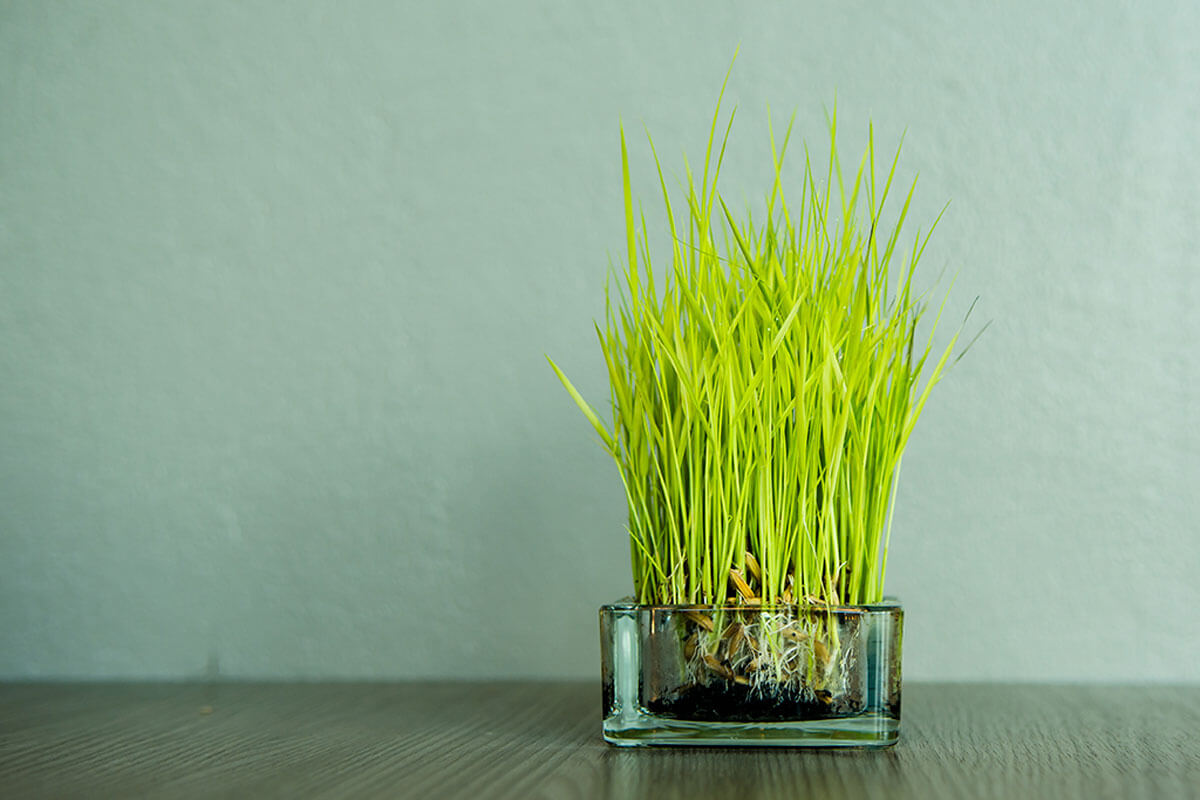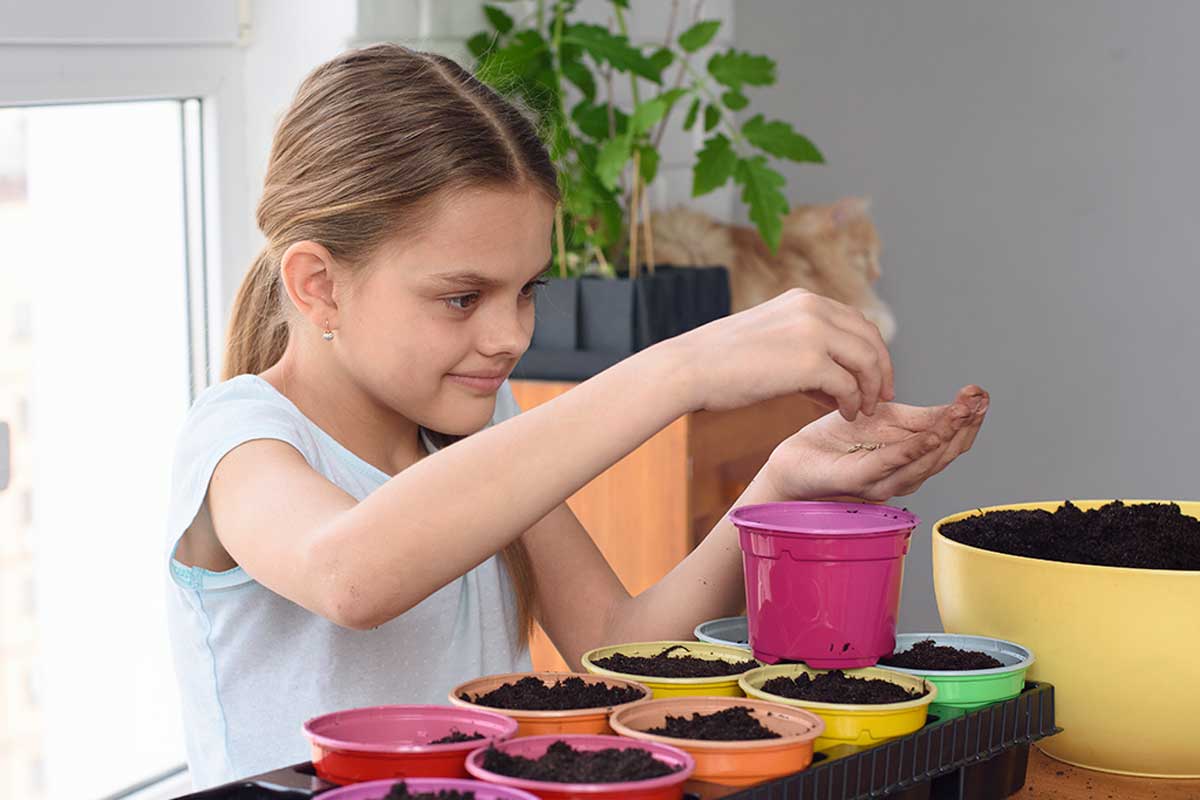Using Wheatgrass for a Natural Decor

Wheatgrass is the germinated sprout of the wheat seed. For it to be considered “grass”, twelve days must pass from the germination of the seed. It’s a type of herb that’s rich in nutrients and is called grass because it reaches around twelve centimeters.
In addition to being used to decorate interior spaces, wheatgrass has a large number of nutrients that provide huge health benefits. Among them, its high content of minerals stands out, including potassium, magnesium, sodium, and calcium.
In fact, it’s been used for a long time as part of gastronomic preparations, due to its nutritional properties. It’s commonly used as an aid to digestion and to help reduce cholesterol levels. So we’re talking about a useful herb in both decorative and health terms.
Can wheatgrass be grown at home?

When looking to use it medicinally, wheatgrass can be purchased ready-to-eat in pharmacies, herbalists, and health food stores. Now, if you want to sow it, you can buy the seeds ready to germinate at home.
Mind you, since it’s all about being environmentally friendly, make sure you buy the seeds that are organic and from a reliable source. This will also ensure that your grass is healthy and green. Following this, we must inform ourselves about its cultivation and harvest.
Remember that direct sunlight can damage the plant. Therefore, place the tray where you plant your seeds near a window where the light will shine on it, but indirectly. In ten days, it’ll be ready for the first harvest, when it reaches twelve centimeters.
How to decorate your house with wheatgrass
Decorating with wheatgrass creates a striking look because its green color is very vivid and combines the different spaces of your home very well. In addition, it provides a feeling of warmth and freshness.
If you like to feel close to nature, don’t hesitate to include it in the decor of your home. We’ll explain the different ways to include wheatgrass in different spaces. Keep reading!
Decorate your garden with wheatgrass

In gardens where there are a variety of plants, it’s a very good idea to also include wheatgrass. This is easy to get, plant, and germinate at home. One of the options is to plant them in pots and place them on shelves or alternatively, directly in the ground.
Because its color is deep green and it doesn’t grow too tall, you can mix it with flowering plants. Without a doubt, the colors of the flowers will stand out much more.
Table centerpieces
One of the most common wheatgrass decorations is found in table centerpieces. Simply choose a tray, vase, or container that’s to your liking, goes according to the decorative style of your home, and just sow the grass. Once germinated, decorate the base with colored stones, glass or crystals, to enhance its beauty.
Children’s rooms

Wheatgrass is also used to decorate interior spaces such as children’s rooms. For the fun and fresh style that characterizes this age group, plant it in patterned and colorful pots. Choose those that are shaped like animals, from your children’s favorite cartoons or movies.
Small pots are generally used because they don’t take up much space and are practical, preventing children from tripping or from tipping them over accidentally.
Wheatgrass is rich in antioxidants and nutrients
Wheatgrass has outstanding benefits, which you should know about. Thus, you can use a little to decorating your spaces. Or you can grow a larger quantity in order to always have it at your disposal.
One of its most outstanding qualities is that it oxygenates the blood. It also has an antioxidant effect that helps with wellbeing, as many authors and studies indicate.
Including this herb in your daily diet provides a good amount of minerals, such as calcium, magnesium, iron, amino acids, and vitamins A, C, B, E, and K.
Wheatgrass is the germinated sprout of the wheat seed. For it to be considered “grass”, twelve days must pass from the germination of the seed. It’s a type of herb that’s rich in nutrients and is called grass because it reaches around twelve centimeters.
In addition to being used to decorate interior spaces, wheatgrass has a large number of nutrients that provide huge health benefits. Among them, its high content of minerals stands out, including potassium, magnesium, sodium, and calcium.
In fact, it’s been used for a long time as part of gastronomic preparations, due to its nutritional properties. It’s commonly used as an aid to digestion and to help reduce cholesterol levels. So we’re talking about a useful herb in both decorative and health terms.
Can wheatgrass be grown at home?

When looking to use it medicinally, wheatgrass can be purchased ready-to-eat in pharmacies, herbalists, and health food stores. Now, if you want to sow it, you can buy the seeds ready to germinate at home.
Mind you, since it’s all about being environmentally friendly, make sure you buy the seeds that are organic and from a reliable source. This will also ensure that your grass is healthy and green. Following this, we must inform ourselves about its cultivation and harvest.
Remember that direct sunlight can damage the plant. Therefore, place the tray where you plant your seeds near a window where the light will shine on it, but indirectly. In ten days, it’ll be ready for the first harvest, when it reaches twelve centimeters.
How to decorate your house with wheatgrass
Decorating with wheatgrass creates a striking look because its green color is very vivid and combines the different spaces of your home very well. In addition, it provides a feeling of warmth and freshness.
If you like to feel close to nature, don’t hesitate to include it in the decor of your home. We’ll explain the different ways to include wheatgrass in different spaces. Keep reading!
Decorate your garden with wheatgrass

In gardens where there are a variety of plants, it’s a very good idea to also include wheatgrass. This is easy to get, plant, and germinate at home. One of the options is to plant them in pots and place them on shelves or alternatively, directly in the ground.
Because its color is deep green and it doesn’t grow too tall, you can mix it with flowering plants. Without a doubt, the colors of the flowers will stand out much more.
Table centerpieces
One of the most common wheatgrass decorations is found in table centerpieces. Simply choose a tray, vase, or container that’s to your liking, goes according to the decorative style of your home, and just sow the grass. Once germinated, decorate the base with colored stones, glass or crystals, to enhance its beauty.
Children’s rooms

Wheatgrass is also used to decorate interior spaces such as children’s rooms. For the fun and fresh style that characterizes this age group, plant it in patterned and colorful pots. Choose those that are shaped like animals, from your children’s favorite cartoons or movies.
Small pots are generally used because they don’t take up much space and are practical, preventing children from tripping or from tipping them over accidentally.
Wheatgrass is rich in antioxidants and nutrients
Wheatgrass has outstanding benefits, which you should know about. Thus, you can use a little to decorating your spaces. Or you can grow a larger quantity in order to always have it at your disposal.
One of its most outstanding qualities is that it oxygenates the blood. It also has an antioxidant effect that helps with wellbeing, as many authors and studies indicate.
Including this herb in your daily diet provides a good amount of minerals, such as calcium, magnesium, iron, amino acids, and vitamins A, C, B, E, and K.
All cited sources were thoroughly reviewed by our team to ensure their quality, reliability, currency, and validity. The bibliography of this article was considered reliable and of academic or scientific accuracy.
- Flores, Y. (2020, 7 octubre). Pasto de Trigo una maravilla natural con grandes beneficios para tu salud. Salud y Vida.
- ¿Qué es la hierba de trigo? ¿Por qué está en mi bebida? (2021, 29 julio). Mayo Clinic.
- Fukushima, C. A. (2019). Germinando tu salud: Los beneficios del Pasto de trigo. Bien Verde Pasto de trigo.







